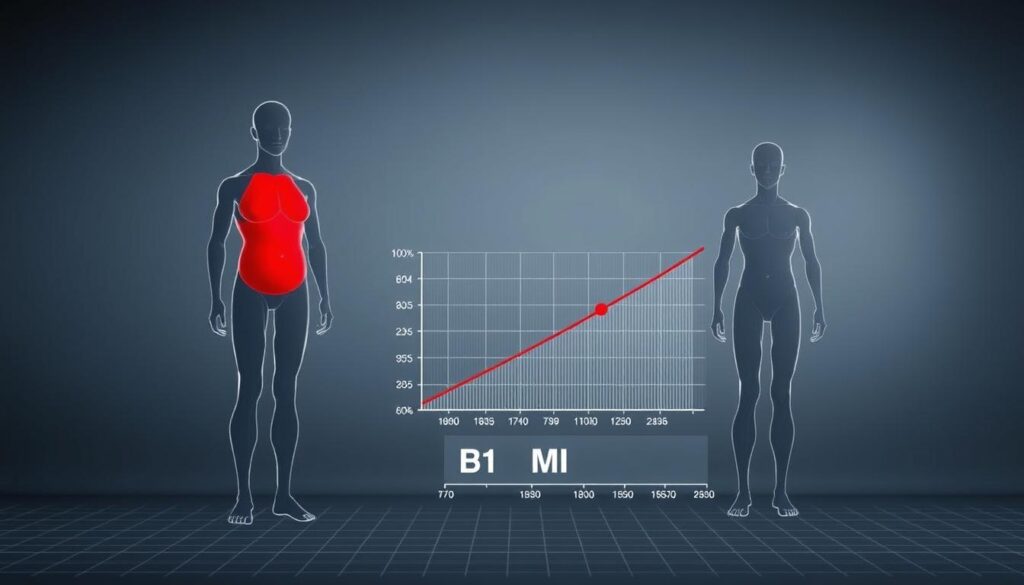“The greatest wealth is health.” – Virgil. This timeless quote emphasizes the importance of maintaining a healthy body composition. When it comes to assessing our health, we often rely on various metrics, but two key measurements are body fat percentage and BMI.
Relying solely on weight can be misleading. We need to understand the proportion of fat in our body relative to our total weight, which is where body fat percentage comes into play.
We will explore how these measurements are used in healthcare and fitness settings to assess health risks and track progress.
Key Takeaways
- Understanding the difference between body fat percentage and BMI is crucial for assessing overall health.
- Relying solely on weight measurements can be misleading when evaluating fitness and health status.
- Body fat percentage measures the proportion of fat mass relative to total body weight.
- BMI is a calculation based on height and weight.
- Knowing which measurement is more appropriate is important for different health and fitness goals.
Understanding Body Composition
The concept of body composition goes beyond mere weight, delving into the proportions of fat, muscle, and bone in our bodies. It is a term frequently used by healthcare professionals to assess an individual’s health and fitness level more accurately than weight alone.
What Is Body Composition?
Body composition refers to the percentage of body fat, bone, and muscle in an individual’s body. It is a more detailed indicator of health because it differentiates between lean body mass (muscle and bone) and body fat. For instance, two individuals may have the same weight but vastly different body compositions, with one having more muscle mass and the other having more body fat.
Why Body Composition Matters for Health
Understanding body composition is crucial for health because it provides insights into the risks associated with excess body fat or low muscle mass. Excess body fat is linked to various health conditions, including cancer, heart disease, and diabetes. On the other hand, having adequate muscle mass is essential for mobility, balance, and overall metabolic health.
The Relationship Between Fat, Muscle, and Bone
The proportions of fat, muscle, and bone in the body are interrelated and influence overall health. For example, as muscle mass increases, metabolic rate can improve, helping in the management of body fat. Similarly, bone density is crucial for overall health, and its decline can lead to conditions such as osteoporosis. Thus, a balanced body composition is key to maintaining overall health and reducing the risk of various health issues.
Body Fat Percentage vs BMI Chart: Key Differences
Understanding the distinction between body fat percentage and BMI is crucial for accurate health assessments. While both metrics are used to evaluate health, they provide different insights into body composition.
What Body Fat Percentage Measures
Body fat percentage directly measures the proportion of fat mass relative to total body weight. This measurement provides a clear picture of body composition, allowing for a more accurate assessment of health risks associated with excess fat.
What BMI Measures
BMI (Body Mass Index) is a calculation based on height and weight that estimates body fat levels. It is calculated by dividing weight in kilograms by height in meters squared. Although BMI is easier to calculate, it does not directly measure body fat.
How These Measurements Compare
While BMI is a useful initial assessment tool, it has limitations. For instance, it can misclassify muscular individuals as overweight or obese despite their having healthy body fat percentage levels. In contrast, body fat percentage provides a more nuanced understanding of health risks. By comparing these measurements, individuals can gain a more comprehensive understanding of their health status.
In conclusion, understanding the differences between body fat percentage and BMI is essential for making informed decisions about one’s health. By recognizing the unique insights provided by each metric, individuals can better assess their health and take appropriate actions.
Ideal Body Fat Percentage Charts by Age and Gender
Achieving and maintaining the right body fat percentage is vital for both men and women across various age groups. As we age, our body composition changes, and so do the ideal ranges for fat percentage. Understanding these changes is crucial for maintaining overall health.
Healthy Body Fat Ranges for Women
Women require a higher percentage of body fat than men due to physiological differences. The essential fat for women is necessary for reproductive health and other bodily functions.
Age-Specific Guidelines
For women, the healthy body fat percentage range varies with age. Generally, for women aged 20-40, a body fat percentage between 21-33% is considered healthy. For those aged 41-60, the range is 23-35%, and for women over 60, it’s 24-36%.
Essential Fat Requirements
Essential fat is crucial for women’s health, particularly for hormone regulation and reproductive functions. Women typically require a minimum of 10-12% body fat to maintain these functions.
Healthy Body Fat Ranges for Men
Men have different body fat percentage requirements compared to women. Generally, men need less fat for optimal health.
Age-Specific Guidelines
For men, the healthy range for body fat percentage also changes with age. For men aged 20-40, a body fat percentage of 8-19% is considered healthy. For those aged 41-60, the range is 11-22%, and for men over 60, it’s 13-24%.
Essential Fat Requirements
Men require a minimum of 2-4% body fat for essential bodily functions. This fat percentage is vital for maintaining health and preventing deficiencies.
BMI Charts and Calculations
Understanding your body mass index (BMI) is crucial for assessing your health status. BMI is a widely used measurement that helps determine whether your weight is in a healthy range for your height.
How to Calculate Your BMI
To calculate your BMI, you need to know your weight in pounds and your height in inches. The formula is straightforward: (weight in pounds x 703) / (height in inches)². For example, if you weigh 150 pounds and are 65 inches tall, you first multiply 150 by 703 to get 105,450. Then, you square 65 (which equals 4,225) and divide 105,450 by 4,225 to get a BMI of approximately 25.
Interpreting BMI Categories
Once you have calculated your BMI, you can determine your weight status. A BMI below 18.5 indicates that you are underweight, while a BMI between 18.5 and 24.9 is considered normal or moderate weight. A BMI between 25 and 29.9 suggests you are overweight, and a BMI of 30 or above indicates obesity.
BMI Limitations
While BMI is a useful tool for assessing weight status, it has its limitations. It does not distinguish between fat and muscle mass, which can lead to misleading results for athletes or individuals with a high muscle mass. Additionally, BMI may not accurately reflect health risks for elderly individuals or certain ethnic groups.
Therefore, it’s essential to use BMI in conjunction with other health assessments to get a more accurate picture of your health status.
Methods for Measuring Body Fat Percentage
Accurately determining body fat percentage involves several techniques, ranging from simple to complex. These methods vary in their accuracy, cost, and accessibility, making some more suitable for clinical settings and others for personal use.
Clinical Measurement Methods
Clinical methods are typically more accurate and are used in professional settings. They provide detailed information about body composition.
DEXA Scans
Dual-energy X-ray absorptiometry (DEXA) scans are considered a gold standard for measuring body fat percentage. They use low-level X-rays to differentiate between bone mass, lean mass, and fat mass, providing a comprehensive view of body composition.
Underwater Weighing
Underwater weighing, or hydrostatic weighing, is another highly accurate method. It measures the difference between a person’s weight on land and their weight underwater. Since fat is less dense than water and lean tissue is denser, this method can accurately estimate body fat percentage.
Air Displacement (Bod Pod)
The Bod Pod uses air displacement plethysmography to measure body volume. By calculating how much air is displaced by the body, it can estimate body fat percentage with high accuracy.
Accessible Measurement Methods
For those who need to monitor body fat percentage regularly, there are more accessible methods available, though they may be less accurate than clinical methods.
Bioelectrical Impedance
Bioelectrical impedance analysis (BIA) sends an electrical current through the body and measures the resistance it encounters. Since fat conducts electricity differently than lean tissue, this method can estimate body fat percentage. However, its accuracy can vary based on hydration levels.
Skin Calipers
Skinfold measurements involve pinching the skin at specific points to measure the thickness of the subcutaneous fat layer. While this method is more accessible and can be done at home or in a gym, its accuracy depends on the skill of the person taking the measurements.
- Clinical methods like DEXA scans and underwater weighing offer high accuracy but are less accessible due to cost and availability.
- Accessible methods like bioelectrical impedance and skin calipers are more convenient but may vary in accuracy.
- Choosing the right method depends on individual needs, including the desired level of accuracy and the frequency of measurement.
Improving Your Body Composition for Better Health
Achieving a healthier body composition is within reach when you combine a balanced diet, regular exercise, and healthy lifestyle habits.
To improve your body composition, focus on consuming a balanced diet rich in fruits, vegetables, whole grains, and lean protein. Regular physical activity, including cardio and strength training, helps burn calories and build muscle mass.
Additionally, getting enough sleep (7-9 hours) and managing stress levels are crucial for maintaining a healthy weight and overall health. By making these lifestyle adjustments, you can reduce health risks associated with excess body fat and improve your overall health and health status.


